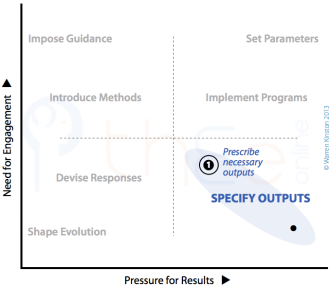Cycle-1: Inner Complexity
Starting Point

With a minimally complex work challenge, there is almost nothing to be organised and no methods to handle. So can start with .
As complexity ratchets up, organisation must move through in which there is a progressive cumulation of value-sets. Each reflects a continuous demand for the values of a particular management method. Once incorporated, no value-set can be given up.
Stage-1: Prescribe Outputs
derived from.
Essence: Necessary outputs have to be prescribed and the worker will perform them at his/her discretion with basic monitoring by the manager.
Consequence: Because workers are allowed maximum discretion here, they will function in line with their training, temperament, interests, temporary preferences and simple expedience.
:

Pressure: As prescribed outputs enlarge in scope, diversity and complexity, tricky issues will emerge that interfere with a satisfactory output and cannot be ignored.
Stage-2: Respond to Issues
derived from .
Essence: Issues develop that disrupt the flow of outputs and require expertise for diagnosis and resolution.
Consequence: Experts work in their own specialized area. Their expertise may be local and practical, or draw on training and disciplinary methods, or some mixture. They typically have rather little interest in or understanding of what others are doing.
:

Pressure: As the number of specialist areas increases, and as the number of experts involved grows, and as output becomes repetitive or extended in time, then complexity escalates. Interactions among the workers and work processes become increasingly chaotic. This disrupts production of outputs and leads to inefficiency and quality failure, with possible legal implications.
Stage-3: Provide Systems
derived from .
Essence: The work processes of individuals and groups doing the work must be structured and regulated to ensure efficiency and adherence to quality standards and legal requirements.
Consequence: Systems and procedures are developed and introduced with a demand that all adhere to them in the course of their work.
:

Pressure: If the opportunity exists for growth (e.g. via the manager's interest, or market success, or government grants), or some of the engaged workers are eager to produce more or different outputs, complexity leaps and the values of a further method get activated.
Stage-4: Organise Programs
derived from .
Essence: Benefits from more and better outputs are usually desirable. However, uncertainties associated with significant growth, especially if that means new developments, pose serious risks that require anticipation and handling.
Consequence: The only way to mitigate growth risks is to start by planning, budgeting and costing developments, and then implementing them as systematic programs using information to track costs, monitor progress and confirm success.
Note: This is a watershed in management sophistication. Outputs are no longer prescribed on an intuitive, obvious basis as at the outset of Stage-1. Instead, they are defined within costed programs and judged worthwhile, and then their delivery is systematically organized and monitored.

:
Pressure: As a successful project-entity operating in in a sophisticated way, it will inexorably grow and start to impact socially. Initially this affects the organization itself and/or the community within which it is situated. Then, depending on the kind of output, it impacts the social environment more widely.
As a result, the social environment starts exerting countervailing pressures with little concern for whatever achievement may be desired. These pressures generate additional challenges and new complexity, which is managed with the more sophisticated modes of Cycle-2.
-
Continue to Cycle-2 of the .
Originally posted: 13-Dec-2013. Last updated: 17-Jan-2014